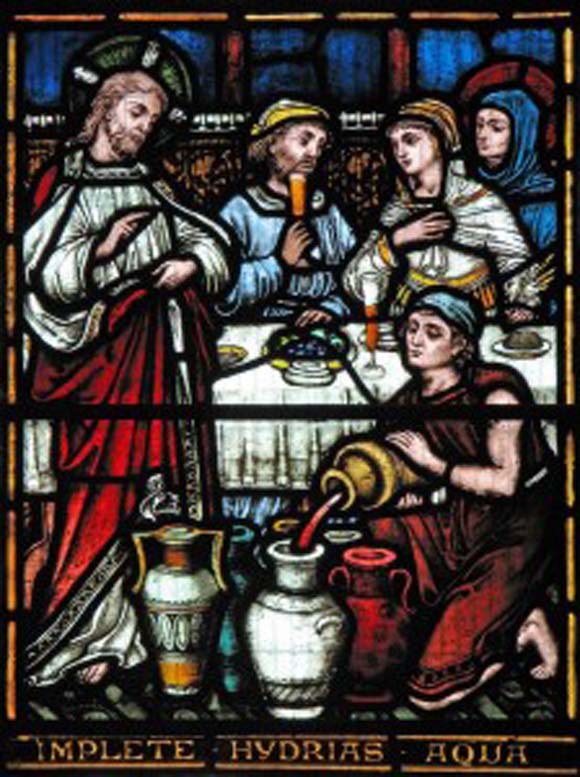
A – Z of the Mass: Wine and Wafer
1.27k
In understanding the Eucharist, it is important to appreciate the difference between signs and symbols. When we see a road sign giving directions to a particular place, the fact that the sign might be green, metallic and rectangular doesn’t tell us anything about the place it points to. A symbol also signifies something, but in contrast to a pure sign, the form of the symbol is crucial. The wine and wafer used in the celebration of the Eucharist are deeply symbolic and so it is very worthwhile to meditate on why Christ comes to us under these appearances.
To begin with, there are many references in the Old Testament. The fact that Jesus used bread and wine in the institution of the Eucharist is reminiscent of the bread and wine offering of Melchizedek in the book of Genesis; Jesus is the one spoken of in Psalm 109, You are a priest forever, a priest like Melchizedek of old. In the book of Exodus the Israelites ate bread at the Passover on the night before they were liberated and they were sustained with bread from heaven in the desert. Another reference is given in Leviticus 23, where the Israelites are commanded to offer the first fruits of bread and wine once they have entered the promised land.
In the New Test ament, apart from the institution of the Eucharist itself, there are also many other references to bread and wine. In Jesus’ first miracle he brings festive joy to a wedding by turning water into wine. In the desert he feeds the multitudes with bread saying, I have compassion on the crowd, because they have been with me now three days, and have nothing to eat; and I am unwilling to send them away hungry, lest they faint on the way (Matt: 15:32). In the Lord’s Prayer, bread is spoken of as our most basic human need. Jesus’ teaching also suggests how bread and wine point to his Passion: Unless a grain of wheat falls into the earth and dies, it remains alone; but if it dies, it bears much fruit (John 12:24). He also talks of himself as the true vine saying, every branch that does bear fruit he prunes, that it may bear more fruit (John 15:2).
ament, apart from the institution of the Eucharist itself, there are also many other references to bread and wine. In Jesus’ first miracle he brings festive joy to a wedding by turning water into wine. In the desert he feeds the multitudes with bread saying, I have compassion on the crowd, because they have been with me now three days, and have nothing to eat; and I am unwilling to send them away hungry, lest they faint on the way (Matt: 15:32). In the Lord’s Prayer, bread is spoken of as our most basic human need. Jesus’ teaching also suggests how bread and wine point to his Passion: Unless a grain of wheat falls into the earth and dies, it remains alone; but if it dies, it bears much fruit (John 12:24). He also talks of himself as the true vine saying, every branch that does bear fruit he prunes, that it may bear more fruit (John 15:2).
 ament, apart from the institution of the Eucharist itself, there are also many other references to bread and wine. In Jesus’ first miracle he brings festive joy to a wedding by turning water into wine. In the desert he feeds the multitudes with bread saying, I have compassion on the crowd, because they have been with me now three days, and have nothing to eat; and I am unwilling to send them away hungry, lest they faint on the way (Matt: 15:32). In the Lord’s Prayer, bread is spoken of as our most basic human need. Jesus’ teaching also suggests how bread and wine point to his Passion: Unless a grain of wheat falls into the earth and dies, it remains alone; but if it dies, it bears much fruit (John 12:24). He also talks of himself as the true vine saying, every branch that does bear fruit he prunes, that it may bear more fruit (John 15:2).
ament, apart from the institution of the Eucharist itself, there are also many other references to bread and wine. In Jesus’ first miracle he brings festive joy to a wedding by turning water into wine. In the desert he feeds the multitudes with bread saying, I have compassion on the crowd, because they have been with me now three days, and have nothing to eat; and I am unwilling to send them away hungry, lest they faint on the way (Matt: 15:32). In the Lord’s Prayer, bread is spoken of as our most basic human need. Jesus’ teaching also suggests how bread and wine point to his Passion: Unless a grain of wheat falls into the earth and dies, it remains alone; but if it dies, it bears much fruit (John 12:24). He also talks of himself as the true vine saying, every branch that does bear fruit he prunes, that it may bear more fruit (John 15:2).
Through the ages the Church has continued to reflect on the significance of bread and wine. The bread and wine are symbols of unity. Many grains go to make the one bread, and many grapes go to make the one cup. Bread and wine also result from a synthesis of gifts – the fertile ground below, and the sun and rain from above, and just as we have a part to play in the making of bread and wine, we play a part in forming the body of Christ, the true vine.
As bodily creatures, we need to use our senses in order for the transcendent mystery of the Divine life to be accessible to us. There is a distance between the symbol of bread and wine and the reality they symbolize – what looks like bread is not bread, what tastes like wine is not wine – but through the words and gestures of the Mass, these symbols transcend themselves and communicate the reality to us that God loves us, He nourishes us, transforms us, and makes us one with Him.



